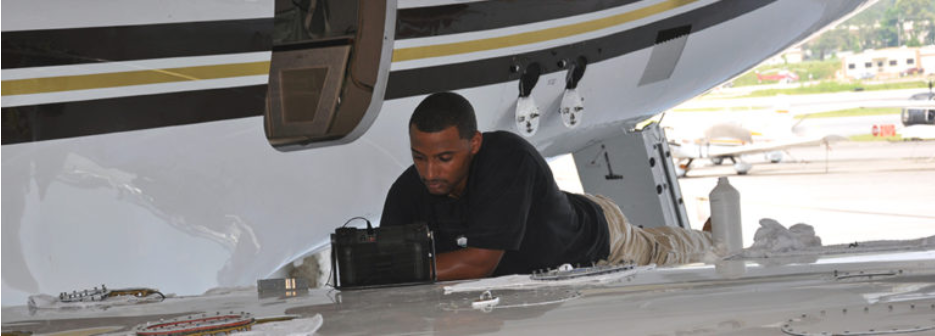What are the Corrosion Inspection Methods?
In every industry that uses metal assets, corrosion becomes a recurring challenge. Unchecked corrosion ultimately leads to asset failures. The discovery and neutralization of corrosion is generally baked into official policies for those industries where failure can be deadly. Using the aviation industry as an example, agencies such as the Federal Aviation Administration create programs built around proselytizing corrosion inspection methods and ensuring that aircraft function optimally.

Preventing corrosion is a continuous effort. Thus, before delving into the available corrosion inspection methods, it is important to differentiate between corrosion inspection and corrosion monitoring. Corrosion monitoring refers to the process of checking specific areas of an asset for corrosion. It is a continuous process aimed at halting corrosion before it spreads. Corrosion inspection focuses on inspecting entire (sometimes hidden) sections of the asset to discover and mitigate corrosion. Hence, in a large asset like an aircraft, the expansive corrosion inspection process occurs less frequently than monitoring.
The three categories of corrosion inspection methods
Three broad classifications apply when describing corrosion inspection methods - visual inspections and non-destructive inspections. In the aviation industry, the visual inspection process involves detailed surveillance of an aircraft while the non-destructive method focuses on using penetrative or scanning technology to conduct corrosion inspections. These methods can be applied in different ways depending on the technology involved.
Starting with a visual inspection, these techniques are applied to evaluate assets for corrosion:
- General Visual Inspection (GVI) — This inspection process consists of the traditional walkarounds that maintenance staff conduct to spot corrosion. The inspector surveys the asset in daylight using natural lighting as a guide or an artificial light source such as hangar lighting or a drop light to extensively check for signs of corrosion. The GVI process may also require access panels, doors, and other components to be removed for inspection.
- Detailed Visual Inspection (DVI) — DVI is sometimes seen as the next logical step after a general visual inspection shows signs of corrosion. In this scenario, a detailed analysis is undertaken to determine the extent of corrosion damage. The inspector will use a good lighting source and magnifying lenses to scrutinize affected areas.
- Electronic Corrosion Monitoring — Electronic corrosion monitors are placed in known problem or hard to access areas of an aircraft to measure the environmental severity and corrosivity. These monitors allow for improved inspection efficiency and maintenance effectiveness resulting in reduced costs and increased aircraft availability.

Non-destructive inspections come with different techniques for spotting and assessing corrosion. These techniques include:
- Dye Penetration — Dye penetrants can be applied to non-porous materials to locate and inspect the extent of surface defects. The dye penetration technique involves the application of a liquid dye to a clean surface and a penetrant developer to discover the extent of corrosion damage. Generally, this technique is conducted under ultraviolet light to better identify the penetration profile of the applied dye.
- Magnetic Particle — This inspection technique is used in detecting surface and near-surface corrosion. The magnetic particle inspection process involves the application of fine magnetic particles to suspicious surfaces or areas. The magnetic field strength is then measured and analyzed to determine the level of corrosion within the target surface.
- Radiographic Inspection — X-ray equipment is employed to first locate and then evaluate the extent of corrosive damage in hard-to-reach places. The radiography process involves the use of an x-ray generator to scan surfaces to discover cracks, structural separations, and material discontinuities - all tell-tale signs of corrosion.
- Ultrasonic Inspection — Generally, ultrasonic inspection is done using a pulse-echo pattern. Ultrasonic energy is passed through a surface and the equipment measures and analyzes the echo's travel time. A similar process called through-transmission ultrasonic (TTU) inspection involves the emission of sound from one transducer to another at the other side of a surface or component. Unlike pulse-echo analysis, TTU units evaluate the quality and quantity of transferred sound to determine the integrity of the inspected structure.
- Magneto-Optic Imaging — The use of machine vision to scan and identify cracks is an excellent way to discover surface, near-surface, and deep defects. The process involves the use of 2D and 3D machines to scan surfaces and joints using imaging lasers. The results are then analyzed to determine the extent of corrosion within an asset.
Effectively tackle corrosion
These corrosion monitoring and inspection techniques can aid in the discovery of corrosion that stems from the tide of damage. Once discovered, the proper cleaning techniques and durable sealant/gasket combinations will halt the spread of corrosion for the foreseeable future. You can speak to an experienced corrosion prevention expert like Av-DEC
to discuss the best prevention techniques for your aviation assets.

